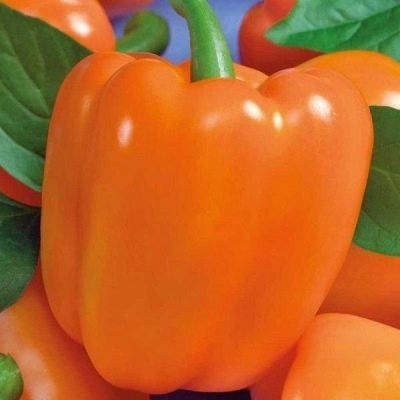
- Authors: Lukyanenko A.N., Dubinin S.V., Dubinina I.N.
- Year of approval: 2009
- Bush height, cm: 55-60
- Growth type: medium-sized
- Fruit shape: cuboid
- Fruit weight, g: 150-200
- Fruit color: in technical ripeness dark green, in biological ripeness bright orange
- Ripening terms: early
- Yield: high
- Average yield: 5-6 kg / m²
The popular sweet bell pepper Jack is more than 10 years old, and during this period a huge number of gardeners managed to grow it. In addition to its great appearance, the fruit tastes great and ripens in abundance. And also Jack is available for cultivation in a wide variety of climatic zones.
Breeding history
A pepper culture called Jack was created by the team of the well-known SeDeK seed-growing company near Moscow. The authors of the variety were breeders Lukyanenko A.N., Dubinin S.V., Dubinina I.N. ground, and in any film shelters.
Description of the variety
First of all, Jack is a variety of sweet pepper, the seeds of which can be independently prepared and used for the next year, which distinguishes this culture from hybrids. The variety also attracts by early maturity, high yield and rather large fruits. And in order to achieve a good harvest, it is quite enough to simply apply standard agricultural techniques.
Characteristics of the appearance of plants and fruits
Jack pepper plant of medium height, bush of a closed structure. The leaf plates are medium in size, there are also large ones, painted in dark green tones, with a slightly wrinkled surface. Fruits on the bush are wilted.
The shape of the peppers is cylindrical, cuboid, the skin is highly glossy, the fruits are colored dark green at the stage of technical ripeness, and in a bright orange tone at biological maturity. Each pepper has 3-4 nests. Fruits weigh 150-200 grams, they are thick-walled, with a wall up to 8 mm.
Purpose and taste
The product is very widely used in cooking for various fresh dishes, all kinds of preparations. Sweet pepper fruits add an exquisite taste to any side dishes, soups, salads.
Ripening terms
The early representative of sweet orange peppers ripens in 105-110 days from the first germination to the beginning of fruiting.
Yield
Jack is a highly productive culture. From one square meter, on average, you can get 5-6 kilograms of delicious peppers.

To get a large and tasty harvest of pepper, you need to take care of the seedlings in advance. When growing pepper seedlings, you need to correctly determine the sowing time, pre-sowing seed treatment, prepare the necessary container and soil.
Growing and care
The Jack sweet pepper is cultivated according to the traditional seedling technique.
Sowing seed should be planned for February-March. Substrate for immersion of seeds can be made independently, using turf and adding peat, compost, humus to it. Seedling care is standard: watering from a spray bottle, a couple of dressings. Shoots will appear in 1-2 weeks.
It is necessary to dive seedlings when one or two leaves appear on them. 10-12 days before transferring to a permanent place, young plants are hardened (grown seedlings are placed in the open air for 20 minutes at first and up to 5-6 hours at the end of the procedure). A transplant can be carried out when the plants are 60 days old.
Seedlings are transplanted into the beds when the air temperature rises to 15-16 degrees, and the soil warms up to 10-12 degrees. For the middle lane, these dates most often fall on the middle days of May.
For 1 sq. m, it is advisable to place no more than 4 peppers, and the depth of the holes is 15 centimeters. The planting scheme is 30x60 cm. The planted plants are regularly watered and fed. Do not forget about loosening and weeding the soil.

To harvest a tasty and rich harvest of pepper, you need to comply with all the conditions of agricultural technology, and proper care begins with planting plants. Before planting pepper in open ground, it should be prepared. It is also important to take care of the seedlings and planting space in advance.




For good growth of pepper bushes and active fruiting, you need to regularly apply mineral and organic fertilizing to the soil. It is necessary not only to choose the right formulations, but also to use them at the right stage in the development of culture. The frequency of top dressing is always individual. It depends directly on the composition of the land on your site. The poorer the soil composition, the more often you will need to feed the pepper.
Disease and pest resistance
Domestic breeding Jack pepper is distinguished by good immune protection against fusarium wilting. However, it does not have increased resistance to other ailments. Therefore, it is necessary to carry out disease prevention.

Pepper is one of the most common vegetables in home gardens. This culture is quite stable and unpretentious. However, under certain conditions, this plant can suffer from infections and harmful insects. Before treating peppers for diseases or pests, you need to find out the cause of the problem, otherwise the treatment may be ineffective.





















































































